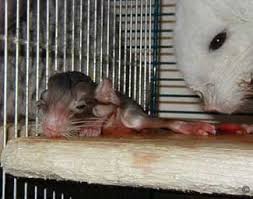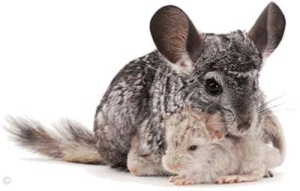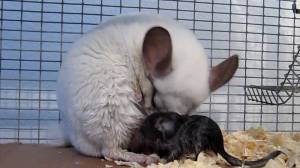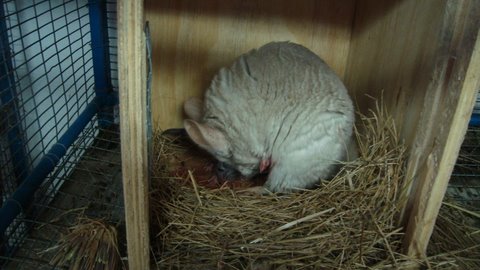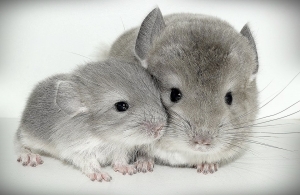 When a newborn chinchilla is healthy and alive, it is a success for both chin mom and the owner. Baby chinchilla are called kits. Expect them to be wet from their mommy chin so you need to dry them because they will get cold. Since they are still babies, they need warmth because their fur isn’t thick enough to cover their skin and their entire little body. Upon birth, they already have 20 teeth, which is very much opposite to human, where we don’t have teeth when we were born.
When a newborn chinchilla is healthy and alive, it is a success for both chin mom and the owner. Baby chinchilla are called kits. Expect them to be wet from their mommy chin so you need to dry them because they will get cold. Since they are still babies, they need warmth because their fur isn’t thick enough to cover their skin and their entire little body. Upon birth, they already have 20 teeth, which is very much opposite to human, where we don’t have teeth when we were born.
A regular baby chinchilla weighs up to 60 grams and counting until they are 2 years old. Some still grow until 4 years old. But the size of a kit is generally 25 grams only and maintenance of food, supplements, vitamins or continuous check up is a necessity.
When they get milk from their mom’s mammary gland, you as a care taker should supervise. They can be overfed or cannot get enough milk with sibling’s competition. They cannot be full or they might get choked, or suffer from acute indigestion. Make sure your every kit gets enough milk and stop them when you think they have had enough.
Things to remember below:
- Check the mommy chin’s mammary glands if they are sore or if she have supplied her kits a good feed of milk. If it’s already sore, you have to keep them away from their mommy chin to prevent unwanted results. You have to be attentive to them. Once the gland is sore and accidentally bitten by the kit, tendency is for mommy chin to react and unfortunately, mother’s touch is not familiar to them of course. They might also bite their kit unintentionally and could leads to severe pain for the kit and could be fatal.
- Once a kit experienced a bite from their mother, tendency is them to limit milk intake, move away from their mom at times, staying just in one place, weak and hungry. Just like a child, they get easily hurt and emotionally hurt. In cases you observed like this, you hand feed them immediately so they are equal with the other kits fed from their mom’s milk.
 The first week is critical. A kit gets easily weak and die if not properly taken care of. You need to check its tail. When the tail is already up and starting to curl, well, that is a sign that you have a healthy baby chinchilla. If the tail does not change from it is being just laid down on the floor after 12 hours from birth, it is not good. The latter sign indicates that the chin have a problem in its body system. It could result to death within that day. Watch out for its curl-up-tail after 24 hours from birth. This means that the kit is very well, hydrated and well supplied with milk.
The first week is critical. A kit gets easily weak and die if not properly taken care of. You need to check its tail. When the tail is already up and starting to curl, well, that is a sign that you have a healthy baby chinchilla. If the tail does not change from it is being just laid down on the floor after 12 hours from birth, it is not good. The latter sign indicates that the chin have a problem in its body system. It could result to death within that day. Watch out for its curl-up-tail after 24 hours from birth. This means that the kit is very well, hydrated and well supplied with milk.
Supply of mommy chin’s milk should not reach 1 month to prevent kits being dependable in milk and won’t try eating hay. They should be trying to eat hay or pellets slowly. They can consume about a half or three fourths of tablespoon pellets at around their 8th week. Give them little by little by hand or by food container. First is pellets. Then hay. Then water. Do not mix because aside from they just mess it, they will lose their appetite. They will not get the right nutrition if happened.
The art of touch is very important. Always hold the chin very light, but tight that they won’t escape. They can jump high remember, and they don’t think of it as a kit, everything for them is just play. Hold and brush their fur very slightly. Their bones are very sensitive and thin, wrong handling, may leads to chin’s pain and death at times.
Chinchillas feature should be checked or examined very carefully. Their eyes, nose, feet, mouth and fur are to be checked everyday, especially when they are still kits. Any discharge from ears, eyes, nose or mouth, rush immediately to the vet. Don’t invent or make any home remedy for them because they cannot talk to tell you what’s wrong with them. Check their feet if they stand well, or any pain you see when they run or crawl. Go to their vet just case you see any abnormality.
Be aware of fur loss and skin abrasions. They might have these, especially if they get to fight with siblings or bite attacks from mom and siblings. Any wound present should be examined to prevent infections or worse, severe pain for chins and death.
14 days after delivery, they can have a dust bath. They cannot be washed with water because it will take days to dry the adult chins and it may cause death to baby chins being cold. Dust bath is done to prevent them from exposing to bacterias or other illness carrier. The kits need warmth and are very sensitive since they were just little.
Around 3 months, the kits should be off from maternal cage and send through the adults normal cage. It is to let them live normally, with no much supervision and for their proper age adaptation of kit to chin. Although it needs a year to say that they are not a kit then, with their little feet, they are still kits in size.
 The female kits of 3 to 4 months can do mating though studies revealed that they do it around 6 months to 1 year of age to begin mating. If that is so, another kits are then to expect in almost 4 months. Remember, life is a cycle, once they are kits, then developed, then get matured and make kits again. Just don’t forget the life of a kit as they grow, the circumstances, cases, what-to-do’s, proper care, what to expect, the things to be followed, the proper food and drink guidelines, physical needs and changes, and their behavioural changes as. Baby chinchilla need a responsible owner so be the one.
The female kits of 3 to 4 months can do mating though studies revealed that they do it around 6 months to 1 year of age to begin mating. If that is so, another kits are then to expect in almost 4 months. Remember, life is a cycle, once they are kits, then developed, then get matured and make kits again. Just don’t forget the life of a kit as they grow, the circumstances, cases, what-to-do’s, proper care, what to expect, the things to be followed, the proper food and drink guidelines, physical needs and changes, and their behavioural changes as. Baby chinchilla need a responsible owner so be the one.
